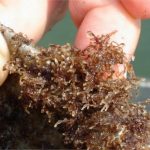Yellowstone River Killer!
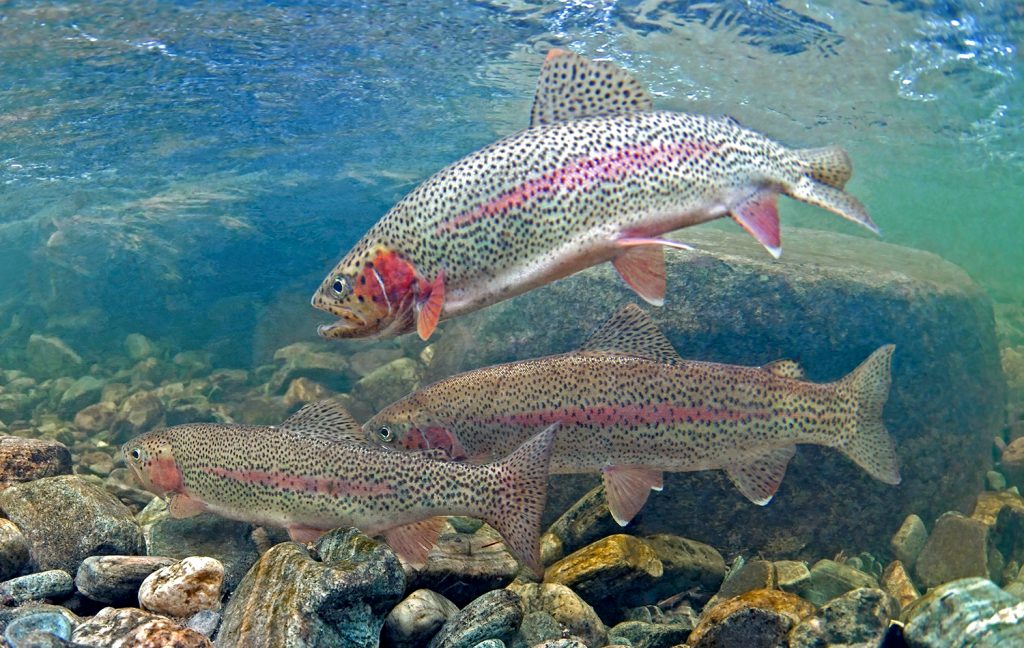
by Greg Lewis
Montana Fly Fishing Magazine interviews a 30-Year Expert in Bryozoans and PKD on the subject of what caused the unsolved fish-kill from 2016-2017
By most guide and outfitter accounts the Yellowstone River has recovered from the year-long event from 2016 to 2017, and in some cases as far as fishing goes anglers are catching more trout per-mile than whitefish in the past. So why revisit this unfortunate episode in our state’s past, some might be asking?
…Because the event still remains scientifically unsolved.
What we know:
In the summer of 2016 the Yellowstone River began experiencing the largest recorded fish-kill in Montana state history. This unprecedented event caused the Fish Wildlife and Parks Department to close the river for a 183-mile stretch, as well as all its’ tributaries for over a two-month period during peak fishing season. This extensive closure resulted in a loss of angling and area tourism business totaling over $500,000.
What we didn’t realize at the time:
Contrary to multiple articles in the local and national press through misinformation provided by Region- 3 FWP, anglers across the globe were led to believe that only native whitefish were killed by the tens-of-thousands in the original event during the river-closure in summer of 2016. This is untrue. Thousands of rainbow, cutthroat, and brown trout, were also decimated during this episode, as the unexplained kill-off carried on throughout the winter and lasted well into the summer of 2017.
This new information was revealed within internal reports and research-work conducted by FWP over the past 16 months, obtained by Montana Fly Fishing Magazine, through special-request in January 2018*.
*Link to source material on numbers http://mtflyfishmag.com/category/blog/
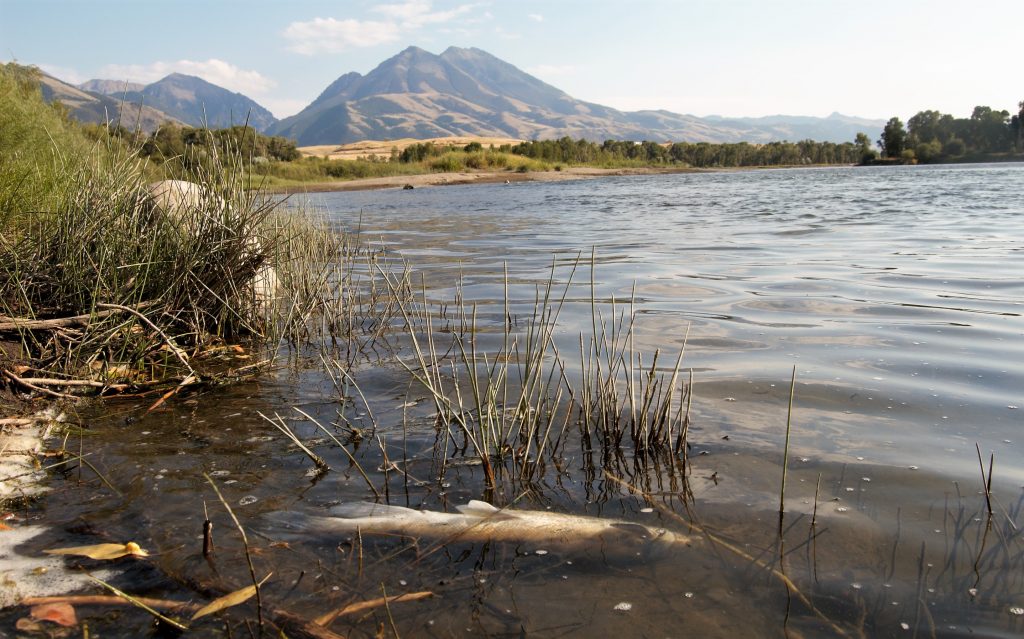
At the time of the initial fish-kill, in August of 2016, I was living year-round in Big Sky. There we had recently experienced what a river looks like only months earlier, in this case the Gallatin, when in early April 30-million-gallons of muddy wastewater spilled out of an effluent pond discoloring the river for over 50 miles. Information had materialized soon afterward amongst those in the conservation community about the potential for direct-discharge in the near future; so, my focus as a journalist was on effluent, capacity-issues, and treatment.
Given that mindset while I was reading the news of the Yellowstone river-closure, I began to wonder if the fish-kill might be related to the upcoming 100th Anniversary of the National Park Service and the anticipated 1-million visitors?
I asked myself a basic mathematical question, how could the small rural-facility designed for 1,800 local Gardiner residents be handling the volumes of raw wastewater being produced, by what had already been estimated to be 900K in tourists annually passing through, over the previous year?
I did some preliminary research online and realized the Gardiner plant was renovated in 2012, yet it was designed for 600,000 annual visitors. The plant has not been expanded since that time, to adjust for the significant increase in tourism. Visitors recorded entering Gardiner in 2016 were 785,032. The estimated increase of +300K, includes those exiting the park through Gardiner.

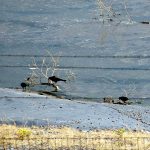
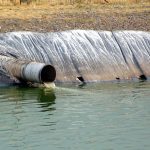
I then began looking into bryozoans and Prolific Kidney Disease in fish species (PKD) online. After a couple days of research, I came up with a name of an expert in the field of “bryozoans and PKD in trout” – the very culprit FWP was now blaming on the massive fish-kill occurring. Since there appeared to be very few scientists dedicated to this field of research,
I emailed Dr. Timothy Wood and after a brief introduction, I asked him this question:
Q) Is it possible, in your professional opinion, the wastewater treatment plant in Gardiner inadvertently flushed some type of bryozoans into the river over the few weeks leading up to the initial fish-kill in August 2016; inadvertently causing this event?
Twenty-four hours later, this was his reply appearing in my in-box:
A) The short answer is: Definitely yes, the discharge of nutrient-rich water at Gardiner could be an important factor in the spread of PKD downstream.Some bryozoans do thrive in wastewater plants, and it is conceivable that the plant in Gardiner is discharging statoblasts or live bryozoan fragments. Whether or not this is really happening, and if so whether those bryozoans are infected with PKD are things we could easily check.
I then followed-up with this question:
Q) FWP originally stated the bryozoan and PKD parasite was “an invasive species, likely introduced by an angler or boater” and that “the fish in the Yellowstone River were naive to it”. Does this sound accurate?
A) Bryozoans and their associated PKD parasites have probably been in the Yellowstone River since the last glaciation. In general, the infection rates are thought to be low and hardly noticeable. If the latest fish kill was really caused by PKD the most likely reasons would include: (1) Increase in the infection rate among bryozoans, (2) increase in the bryozoan population, (3) a lowered resistance to infection among fish, and (4) a change in the virulence of the parasite.
| Dr. Timothy Wood has published over 60 scientific papers, books, and book chapters on freshwater bryozoans; * Named 26 species of bryozoans; * Conducted full bryozoan surveys in Ohio, Illinois, Britain, Ireland, Panama and Thailand; * Published the first molecular genetic phylogeny of freshwater bryozoans; * Currently serving as elected President of the International Bryozoology Association. |
An FWP Introduction Gone Wrong
This information (above) shared by Dr. Tim Wood, was then immediately relayed to FWP officials at the public meeting in Livingston on August 24 2016. The meeting was designed for FWP to explain the river-closure and was attended by over 300 concerned locals, a senator, and news media.
About 20 minutes before it began I spoke to Sam Shepard, who was at the time Region 3 Supervisor, as well as Dr. Eileen Ryce. I read the information that the expert had said “the bryozoan and parasite have been in our rivers for hundreds of years and are commonly transported by waterfowl”, thus impossible to control. They both openly dismissed my input, then went on stage to further spread a false narrative riddled with multiple inaccurate statements, as to what was occurring on the river.
All attempted connections afterward between actual experts on bryozoans and Region 3 FWP, were dismissed in 2016.
After reading countless articles filled with false information between Region 3 Fisheries and the press, as well as a second fish-kill occurring in the summer of 2017, (when recorded-flows were higher and water temps much colder), I decided to conduct this in-depth interview.
| – What is a Bryozoan?
|
New Information
Q) Would bryozoans be considered an “invasive species” such as zebra mussels?
A) No, not at all. The bryozoans harboring PKD are well established across five continents. They occur throughout North America, especially in cold, flowing waters like the Yellowstone River. By contrast, zebra mussels invaded North America from Europe about 30 years ago and we are now seeing them move across southern Asia – a true invasive species.
Q) How is the bryozoan most commonly spread from river to river and commercial bodies of water?
A) Most freshwater bryozoans produce dormant capsules about the size of a period in newsprint. Called statoblasts, these can survive freezing, drying, and other harsh conditions. We know that statoblasts are
easily transported by waterfowl – on the feet, feathers, and even in the digestive tract. However, I have found bryozoans in glacial lakes at high elevations where waterfowl seldom go, and I have no idea how they got there.
Q) Besides your 30+ years as a professor at Wright University in Ohio, you also own and operate a commercial company called: Bryo Technologies, which routinely treats certain commercial facilities of bryozoan outbreaks. (www.bryotechnologies.com). What types of problems can bryozoans cause inside these facilities and what does your company do to stop the spread?
A) The problems we fix begin when water from a lake or river is drawn through a pipeline. Very soon things are growing on the inner pipeline walls. Among these are zebra mussels, which most people know, but there are also bryozoans, hydroids, peritrichs, sponges, and other unfamiliar aquatic pests. They can completely block a pipeline, or if they break loose they can clog equipment.
This is what we deal with, and it is a very common problem. Every situation is unique, but over the years we have developed a variety of successful methods to handle them.
Q) How many years have you been studying bryozoans and their association with Prolific kidney disease in trout species?
A) As a graduate student in Colorado in 1968, I discovered a way to grow bryozoans in the laboratory. One of the species I worked with was Fredericella, which is now known to be the primary carrier of PKD. In those days I knew nothing of PKD but I did notice tiny, sac-like things moving around inside the bryozoans, very likely the PKD parasite itself. Years later I collaborated with Dr. Beth Okamura to study myxozoan parasites in bryozoans, which led directly to discovering the link between these parasites and PKD in salmonid fish.
Q) What is the relationship between PKD and bryozoans?
A) PKD is essentially a bryozoan disease. Bryozoans with PKD can infect other bryozoans, they can infect the next generation of bryozoans, and they can also (accidentally) infect salmonid fish.
Fish with PKD cannot pass the disease to other fish, they can only re-infect bryozoans. So, without infected bryozoans there would be no PKD in fish.
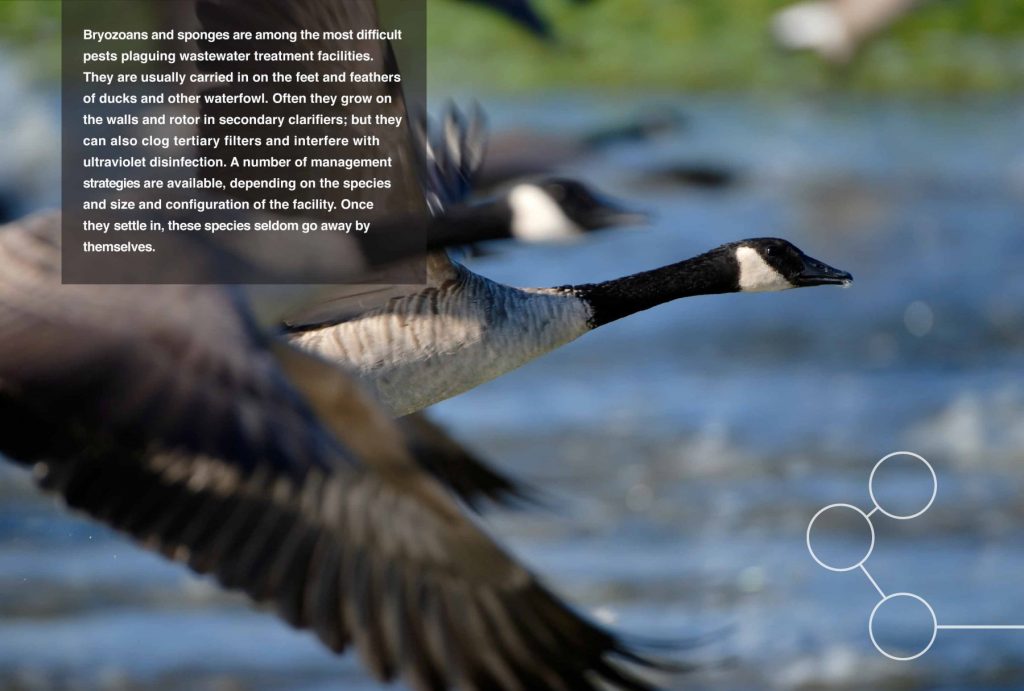
Q) In spring of 2017, FWP reported they found an entire larger age-class of trout missing from the Yellowstone river in roughly the same general location as 2016 year’s fish kill*. While they initially reported that the public shouldn’t make the connection to last year’s event, given ice scourging and possibly it being a cyclical event was to blame, now that we experienced another fish-kill this past year, isn’t it plausible that we’re actually experiencing a PKD event still unfolding?
A) It does seem unlikely that there would be a single isolated PKD event without the effects rippling into the following years. But I would emphasize that we know little about how PKD operates in the natural world. Most of the research so far has been clinical, not ecological. Regrettably, there are no PKD data from the Yellowstone River in years prior to the recent fish kills.
- NOTE: Records provided by FWP in 2018 show “a population decline, of as many as 50% in all trout species”: Brown, rainbow, and cutthroat occurred between 2016-2017 on the most impacted stretches due to PKD. This information was verified in more detail within FWP’s internal records and research work, which was obtained by Montana Fly Fishing Magazine in January 2018.
……………….
Q) In your scientific research could a substantial increase in arsenic, which was being introduced to the wastewater facility in Gardiner, have any impact on the bryozoans present?
A) Possibly, but the fish would be affected even more.
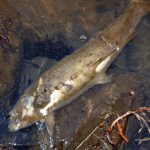
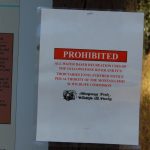
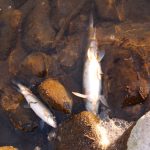
| Arsenic –
It was revealed in an article published in the Bozeman Daily Chronicle on Oct. 20, 2017 that “high levels of arsenic were found in the district’s sewage treatment facilities”, originating from a leaking pipeline in YNP. This has now resulted in a $2-million-dollar lawsuit. According to the complaint an engineer told the district in February 2015 that high levels of the odorless chemical were entering the treatment facility. The engineer also said that 95 percent of the arsenic was coming from Yellowstone, and testing showed the park’s sewage had levels nearly 40 times that of Gardiner sewage. The Montana Department of Environmental Quality had directed the district to empty the ponds, but the engineer recommended they wait to do so until the park fixed its arsenic problems, according to the complaint. The Gardiner treatment facility legally and routinely discharges its treated effluent into the Yellowstone River. Source: Link |
Second Recorded Fish Kill – August 2017
Q) Is it possible that the theory which FWP reported as recently as August 2017, “that the bryozoan colony, or host, was swept below last years’ kill- site during ice-out”, and now this is why the 2017 fish-kill occurred 20 miles downstream?
A) No, this does not strike me as very plausible. Most freshwater bryozoans overwinter in the form of dormant statoblasts attached firmly to rocks. It is unlikely that these would be significantly affected by ice-out.
Q) In your experiences treating wastewater facilities and nuclear cooling ponds for bryozoan outbreaks how does the bryozoan grow to some problematic proportions and what does your team do to stop it from recurring?
A) Many bryozoans grow best with continuously flowing water and plentiful food. To control these populations, we use a variety of chemical and nonchemical tools, all depending on the species, water chemistry, and characteristics of the site. There is no single solution that works in every case.
Q) At the heart of the 2016 fish-kill and where biologists also located dead whitefish again in 2017, a vital tributary, or artery known as Mill Creek, has long since been cut- off from reaching the river due to ranchers’ diverting 100% of its spring and summer flow.
That much lower volume, (if any) which does eventually enter the river, after usage for commercial scale agriculture is then from irrigation ditches or leaching along the edges of fields; with fertilizers mixed within the water. Could this be a possible factor in the spread or bloom of bryozoan colonies, and a potential cause of PKD outbreaks in the hardest-hit areas?
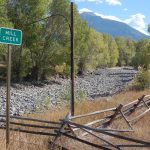
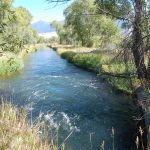
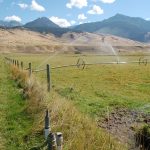
A) Possibly. We do know that elevated nutrient levels in the water promote strong growth in bryozoans. Whether this also promotes higher infection rates by PKD parasites is not known.
……..
Q) Could a wastewater plant performing a by-pass, either authorized or unauthorized, and sending into the river system untreated sewage be the cause of the bryozoan/PKD outbreak?
A) Yes. It has been shown that the nutrients from wastewater have a positive effect on the growth of bryozoans, including the species that carries PKD.
Q) There were reports by FWP in May 2017, of “septic shock as the cause of death in whitefish in the hardest hit areas of the 2016 fish-kill”. Does this sound correct?Have you or colleagues ever experienced or witnessed anything on this scale before in hatcheries or in nature?
A) I am not aware of any instance where a massive release of PKD spores resulted in septic shock in fish. If this has been reported by FWP it would be reasonable to inquire about any evidence.
Q) Why is FWP calling Prolific Kidney Disease now PKX?
A) PKD is proliferative kidney disease; PKX is an old term for the parasite causing PKD. For a long time, it was clear that another species was involved in the life cycle, but no one could discover what it was. The “X” represented the unknown species. Now that bryozoans are known to be the final hosts the expression “PKX” has fallen out of use.
Q) Can anglers do anything to help stop the spread of bryozoans from one river to another?
A) It is always a good precaution to hose off boots and other equipment before entering a new fishing site. Live bryozoan fragments or statoblasts can adhere to fishing gear, especially in standing water. The statoblasts remain viable even after being dried or frozen for months.
Q) FWP stated in early media reports and also at the meeting held in Livingston after the Yellowstone River-closure, that they “had only located both the bryozoan and PKD parasite in two isolated locations in the past 20 years, Cherry Creek and an irrigation ditch (neither related to a fish-kill)”; yet in your paper on the subject: Bryozoans as hosts for Tetracapsula bryosalmonae, the PKX organism it was recorded as present in Ennis Lake and the Lower Madison in 2000. How did you come to find both the same bryozoan and PKD parasite in this region and for whom were you doing research at the time (or from where was that information gathered)?
A) From various sources we compiled a list of sites where PKD had been reported. The goal of this study was to find out what bryozoan species occur in the same vicinities. The species we found were well known across the northern states. This work was funded by the Natural Environment Research Center in the UK.
Q) The question most asked after these back-to-back fish kills is why the Yellowstone river is seeing reactions when both the bryozoan and parasite are in all of our rivers? If it were merely temperature and flow rate which is triggering it, certainly the Jefferson, Lower Madison, or Big Hole, should have experienced mass fish-kills, since both rivers’ flows are typically lower and warmer (and Hoot Owl restrictions* go into effect on) well before the Yellowstone’s levels drop. So why the Yellowstone?
A) Bryozoans are a normal part of any healthy river ecosystem, and they probably occur in every river system in Montana. However, we do not know where the PKD parasite occurs or how much of any bryozoan population is likely to be infected.
*NOTE: Hoot Owl restrictions are when FWP halts fishing after 2PM to alleviate pressure/stress on trout during high water-temps.
Q) Also, why is a certain section seeing a fish-kill if temperatures and low-flows are a cause? Others have questioned why wouldn’t the degree of fish-kill be more extreme much further downriver where water is even lower and thus much warmer?
A) These are good questions that need to be asked. At this time, I have no answers for you.
Q) Why do you suppose the parasite is targeting whitefish primarily, versus rainbow or brown trout? Or do you think it is and we’re just not seeing as many of the latter*?
A) Scientists now believe there are many different strains of the PKD parasite, and some of these may be more lethal to whitefish than to other species. At this point we are still learning to distinguish one strain from another.
*NOTE: Information was later revealed within internal FWP reports, to indicate thousands of trout also perished between the summers of 2016-2017.
…………..
Q) Approximately how many times have you corresponded with Montana FWP and state officials since 2016-2017 fish kills? Have they been asking related questions?
A) We initially made half a dozen contacts with various people. There seemed to be very little interest, and no one has responded with questions of their own.
Q) In your initial written proposal to FWP in September 2016 you laid out a plan that you and your team would conduct if the state brought you in to help research the fish- kill. It appears they simply read your outline and followed your proposed methods themselves. Has anything like this occurred before?
A) Our proposal contained no privileged information. FWP was free to use it any way they wished. However, following through with those ideas would have required specific experience and knowledge that FWP seems to lack. For that reason, they may have given the proposal a low priority. We found a similar non- response from the State of Idaho, where there have been numerous unexplained fish kills on the Snake River.
Q) Do you think it was perhaps because of budgeting reasons or cost concerns, why FWP decided not to bring your team in?
A) Cost was never discussed as we’d not yet determined the amount of time required to investigate the outbreak and its potential causes. I think a more likely reason is that FWP preferred to focus on the fish rather than the less familiar bryozoans.
.…………………
Proposal for Research – 2018
Q) Would your scientific findings after a two-week research project on the Yellowstone, then be of benefit to other scientists and students studying PKD outbreaks, once its completed?
A) Absolutely. Most studies of PKD have been done in laboratories. This would be one of the first actually performed on site.
Here is what we want to know: What is the population size of bryozoans in the study area and how are they distributed? What is the infection rate? Can we identify PKD “hotspots?”
If so, do they suggest possible factors triggering the PKD outbreaks? Can we identify steps to be taken that would decrease the likelihood of another severe outbreak?
There may be additional information of interest mainly to researchers: is there more than one bryozoan species harboring PKD parasites? Is this the same PKD strain that afflicts trout farms in Europe? Etc.
Q) Could the two events, or back-to-back fish kills on the Yellowstone during August 2016/2017, be something that is naturally recurring and possibly something to some degree we might experience annually from now on?
A) I certainly hope not. But I think the people supporting this investigation are taking the right approach. You can speculate all day about PKD outbreaks and what the future holds for the Yellowstone River, but without reliable data it is just talk.
I look forward to investigating the PKD outbreak area in 2018. If all goes well we will be able to provide some real answers.
……………………….
If you support further research on the Yellowstone, conducted by actual experts on bryozoans and PKD, please sign our petition at: https://www.change.org/p/montana-fish-wildlife-and-parks-montana-fwp-more-research-needed-on-the-yellowstone-river-fish-kills
Here is the link to the 2018 Research Proposal and the dedicated website for more information: http://www.yellowstoneriverfishkill.com

